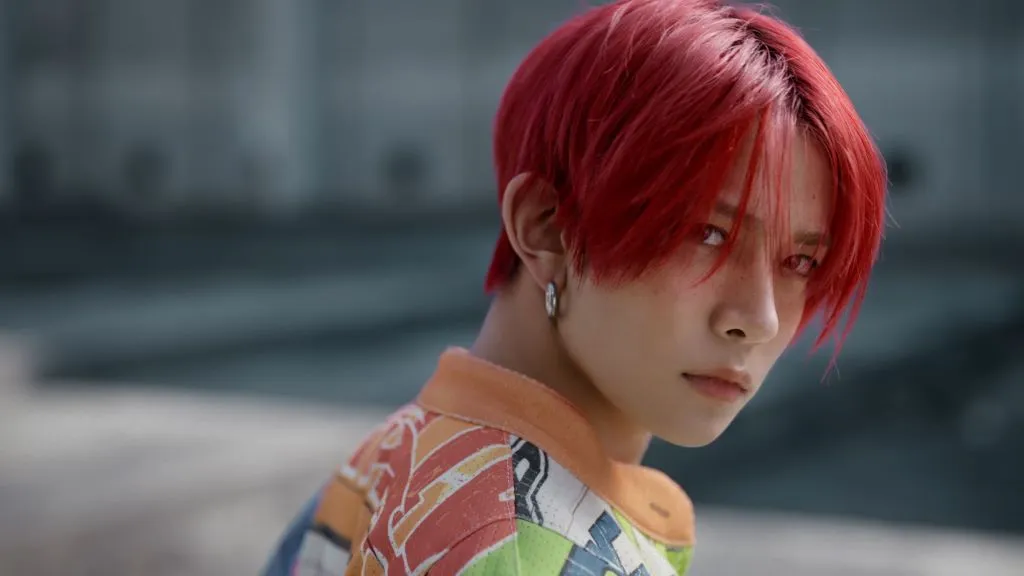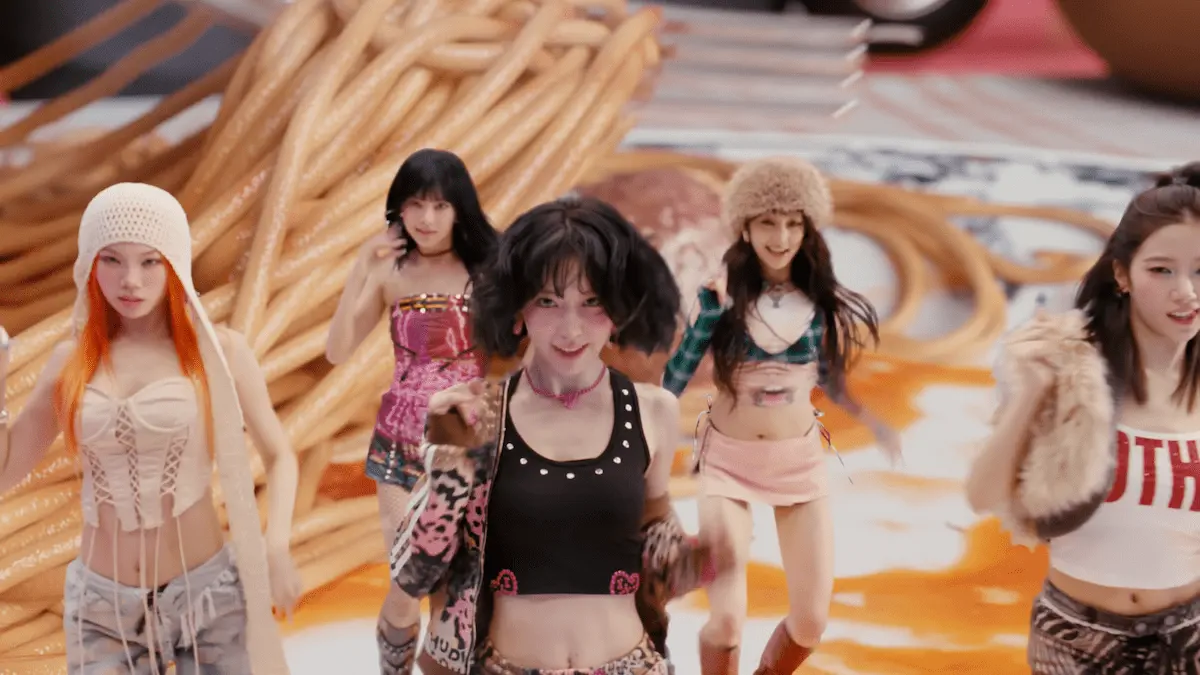NMIXX's 'Blue Valentine' Explained: When Love Leaves Bruises You Don't Want to Heal
First listen, I thought: this is interesting. Bright and light, yet somehow sad at the same time.
Second listen, paying attention to the concept, lyrics, and vocal performance—I found myself smiling through tears by the end. The more I hear it, the closer it gets to genuine sadness. But not the kind that breaks you. The kind you choose to hold onto.
That’s Blue Valentine. NMIXX’s first full album title track, and the moment three years of experimental persistence finally crystallized into something undeniable.

Source: Official NMIXX YouTube (© JYP Entertainment)
Table of Contents
Quick Facts & Credits
This is NMIXX’s first full-length album—a milestone that carries weight in an industry where many groups never make it past mini albums. Three years of refinement led here, and you can hear every lesson learned.
First Listen: Three Times Deep
First listen, brain off: This is… curious. It sounds bright and airy, almost optimistic. But there’s this underlying melancholy I can’t shake. Like watching someone smile while holding back tears.
Second listen, paying attention: I focused on the concept, read through the lyrics, really listened to the vocal choices. By the end, I realized I was doing exactly what I just described—smiling with wet eyes. The song isn’t hiding its sadness. It’s just not making sadness the only story.
Third listen onward: The more I play this, the sadder it gets. Not darker—sadder. There’s a difference. It’s the sadness of choosing to feel something painful because the alternative is feeling nothing at all. And somehow that choice feels right for this album. This is the perfect title track for what NMIXX is trying to say.
But here’s my concern, and I’ll get to this later: will general audiences sit with this long enough to feel what I felt on the second and third listen? Or will they hear “interesting song” and move on?
The Bruise You Choose to Keep
The song keeps coming back to this image: 파랗게 멍이 든 my heart. A bruise that’s turned blue. Cold. Physical evidence of impact.
And then it says something that made me stop: 낫지는 않길. ‘Cause it’s you.
I hope it doesn’t heal. Because it’s you.
That line reframes everything. The bruise isn’t just pain—it’s proof that something real happened, that you felt deeply enough to get hurt. And the narrator would rather carry that proof than heal and forget. There’s something quietly devastating about that choice.
The Hot and Cold That Won’t Resolve
The lyrics are full of temperature imagery that refuses to settle:
“식어버린 너의 색은 blue” (Your cooled-down color is blue)
“식어도 타오르는 얼음 속 불꽃” (A flame in ice that burns even when cold)
“Hot and icy / But I like it / It’s so you”
This isn’t confusion. This is accuracy. Relationships don’t maintain single temperatures. They oscillate—sometimes within the same conversation. You’re exhausted and energized. Finished and desperate to continue. NMIXX captures that whiplash without trying to resolve it into something tidier.
The contrast is constant: flame in ice, fearless hand reaching out, weather changing, being lonely together. It’s emotional whiplash that somehow feels completely true—the urgent, almost frantic energy of trying to explain something that doesn’t make logical sense but feels absolutely right.
The Part Where You Dive Back In
“If this love is over / 다시 뛰어들어 난”
If this love is over, I’ll dive back in.
That line repeats as both acceptance and defiance. It’s not denial—they know it’s probably over. But they’re choosing to fall back into it anyway, knowing the outcome, because experiencing it fully matters more than protecting yourself from pain.
A Japanese comment said it perfectly: “普遍的でストレートな愛についての歌でありながら、ただの女性アイドル曲として決して消費され尽くされない、しなやかな強さを持った美しい楽曲” (A song about universal, straightforward love, yet it possesses a graceful strength that prevents it from being consumed as just another female idol track).
That’s exactly it. Blue Valentine refuses the clean ending. It stays in the complicated feeling.
What the MV Shows You (And What It Means)
The video opens in golden hour—that specific light that only exists for about twenty minutes a day. It’s memory, nostalgia, looking back at something just out of reach.
The Temperature Shifts Made Visual
The color grading does real work here. Watch how it oscillates between warm (golden, amber, soft pink) when the members are together, and cool (blue, gray, desaturated) for solo shots or moments of emotional distance.
At 1:32, there’s this striking moment with Lily where the lighting goes intense—almost angry. One fan called it “머리에 불이 날 정도” (enough to set your head on fire). It’s a brief flash of uncontrolled emotion cutting through the otherwise controlled visual landscape. That heat in the cold.
The Scene Everyone’s Talking About
At 1:50, the most symbolic visual sequence begins. The members perform choreography among massive skeletal structures—ribcages the size of buildings, bones that could be architectural or anatomical.
Multiple comments compared it to Attack on Titan, and honestly, they’re not wrong. There’s something both beautiful and unsettling about dancing among ruins that size. It’s literally performing inside the remains of something that used to be alive. The metaphor is obvious but effective: love as aftermath, as massive structures you move through even after they’ve stopped functioning.
One Korean comment captured it: “뼈 같은 곳에서 춤출 때 해원이 표정 착장 메이크업 안무 애티튜드가 다 너무 이쁨” (When they dance in that bone-like place, Haewon’s expression, outfit, makeup, choreography, attitude—everything is so beautiful). The beauty inside the ruins. That’s the visual thesis.
The Moment That Broke Me
At 2:57, the production strips almost completely down. Haewon’s voice carries the emotional weight alone—soft, breathy, vulnerable in a way that power vocals could never achieve.
Listen to how she delivers it. There’s this slight waver, the breath control that lets you hear the humanity in it, the intentional softness. Korean fans specifically called this out: “개인적으로 이번 노래는 마지막에 해원이 음색이 노래를 더더 살려준다” (Personally, Haewon’s tone at the end really brings the song to life).
That moment is the exhale after holding your breath through an entire relationship. It’s honest admission before the final chorus where they choose, again, to dive back in anyway.
The video concludes with a brief scene at 3:02—Haewon gently drying and embracing Bae, who’s emerged from cold water. It’s the visual resolution to all that temperature imagery. After all the cold, someone chooses to provide warmth. After all the falling, someone chooses to hold on. That’s the “fire I’ll keep lit in mine” made visible.
Why the Music Finally Works
Three years of mixx pop experimentation built the foundation for this. The difference? Blue Valentine has the confidence to breathe.
The Tempo Shift That Finally Flows
NMIXX’s signature move has always been the tempo change—slow verses exploding into urgent choruses. Previous tracks sometimes felt like two songs stitched together, and the seam showed. Blue Valentine is seamless.
The verse pulls you in with restraint, almost melancholic. The pre-chorus builds tension. Then at 0:42, there’s this sharp shift—the tempo kicks up, the production tightens, and you feel the energy change before the main chorus even hits. When it does land at 0:56, it feels earned rather than jarring.
A fan articulated what changed: “처음 믹스팝이라 하면서 나왔을 땐 그냥 이어붙이기라 생각했는데, 포기하지 않고 계속 파고들어서 이제 정말 섞이는 느낌이 드네” (When mixx pop first came out, I thought it was just stitching songs together, but they kept digging deeper and now it really feels mixed).
That’s it exactly. This doesn’t feel stitched. It flows.
The Production That Lets Them Breathe
Despite the cold imagery in lyrics, the production is surprisingly warm. There’s organic instrumentation mixed with electronic elements—guitars you can actually hear, drums that sound played rather than programmed. It creates intimacy that their earlier, more aggressive production couldn’t achieve.
The vocal production shows restraint too. You hear breath, texture, the individual qualities of each voice. Sullyoon’s parts particularly benefit—her tone has this soft, slightly fragile quality that over-processing would destroy. They wisely left it alone.
One Japanese comment said: “占い師と名乗った狂人: エンミって全員歌上手いのになんで歌唱スキル必要としないキャッチーな歌ばっかり歌わせるんだろうって思ってた。これは最高!歌のうまさが凄い生きてる” (I always wondered why NMIXX, with all their vocal talent, kept getting songs that didn’t require vocal skill. This is incredible! Their singing ability really shines through).
Finally, a song that uses what they can do.
Why This Landed Now
The Season Made It Real
The song dropped precisely as autumn temperatures hit Korea—that specific moment when you need a jacket in the morning but not by afternoon. Fans kept mentioning this: “진짜 환절기의 따뜻하고 쌀쌀함이 오고 가는 가을이 눈에 보인다” (You can really see autumn with its back-and-forth between warm and chilly).
Blue Valentine captures transitional season energy perfectly. Not quite summer, not yet winter. Still holding onto warmth while accepting cold is coming. Multiple comments called it “가을의 캐롤” (autumn’s carol), and that descriptor is spreading. It’s the song you’ll think of when this season returns.
The timing wasn’t luck. It was understanding that songs don’t exist in a vacuum. Released in July or February, this would’ve landed differently. October was the moment this particular emotional temperature made sense.
Three Years Earned This
NMIXX is three years post-debut now, releasing their first full album. They’re not rookies proving themselves anymore. They’re established artists who can trust their audience will follow them somewhere softer.
The confidence is audible. They’re not forcing experimental elements to prove they can. They’re not trying to be difficult. They’re just making music that interests them, trusting their technical ability to execute whatever the song requires.
One comment from a non-fan captures the shift: “타팬인데 진짜 노래 개좋음. 올해 연말곡은 너다” (I’m from another fandom, but this song is incredible. This is THE year-end song).
When people outside your fandom claim your song, you’ve transcended.
The Balance That Took Time
Blue Valentine is their most accessible title track without sacrificing identity. Earlier releases demanded you meet them on their terms—take it or leave it energy. This meets you halfway. It has melodic hooks, emotional immediacy. But it’s still unmistakably NMIXX in a way nobody else sounds like.
A Korean comment said: “대중성도 잡고 엔믹스 색깔도 놓치지 않았고 진짜 완벽해” (They captured public appeal without losing NMIXX’s color, and it’s perfect).
That balance—accessibility without compromise—took three years to achieve. You can’t rush that kind of refinement.
The Risk I Keep Thinking About
Here’s what I can’t stop considering: Blue Valentine rewards patience and repeat listens. That’s not how most people consume music anymore.
The general public might hear “interesting song” and move on. They might not sit with it long enough for the sadness to surface, for the emotional complexity to reveal itself. First listen gives you novelty. Second listen gives you depth. Third listen gives you the full emotional arc. But will casual listeners make it to the second listen?
NMIXX has always asked for patience. Their music doesn’t give everything away immediately. Blue Valentine is no different—it’s sophisticated enough to require attention, sophisticated enough to reward it.
Early signs suggest it’s working. The chart performance (hitting #1 on Bugs, climbing to #12 on Melon), the YouTube engagement (20M views in 3 days—their fastest ever), the cross-fandom support—people are staying with it.
But the real test is longevity. Will this be the song they’re remembered for, or will it be “that interesting one they did in October”?
I think it’s the former. The comment sections across Korean, Japanese, English, and Chinese all tell the same story: people who initially dismissed NMIXX are coming back. Non-fans are actively streaming to help boost wins. Three years of “they’re too experimental” is shifting into “they’re one of a kind.”
One Chinese fan wrote: “出道三年零八个月,我们终于迎来了第一张正规专。感谢你们的坚持,NMIXX就是一部绚烂、勇敢、真挚的少女史诗” (Three years and eight months since debut, we finally welcome the first full album. Thank you for persisting. NMIXX is a brilliant, brave, and sincere girls’ epic).
That wait wasn’t wasted. It was necessary refinement.
What This Proves
Blue Valentine demonstrates that experimental groups can find their audience if given time to refine their vision. NMIXX’s path from “polarizing” to “praised” offers a blueprint:
Maintain artistic consistency. Don’t chase trends just because the first approach didn’t immediately work. Trust technical excellence—their vocal ability gave them credibility even when songs divided audiences. Refine rather than abandon. Wait for the audience to adjust, because sometimes you’re not wrong—you’re just early.
They didn’t chase trends. They refined their own sound until it became undeniable.
A Korean comment said it simply: “남들하는 뻔한 노래하지않고 자기만의 길을 걸어온 엔믹스. 지금이 엔믹스의 전성기 시작인거지” (NMIXX walked their own path instead of making predictable songs like everyone else. This is just the beginning of their prime).
I believe them.
Sources & Credits
Primary Sources:
- NMIXX “Blue Valentine” Official MV
- Blue Valentine Lyric Translation
- Blue Valentine Analysis Video
- YouTube Comment Analysis (Korean, Japanese, English, Chinese communities)
Album Context:
- Album: Blue Valentine (1st Full Album)
- Release: October 2025
- Significance: First full-length album after 3 years
- Chart Performance: #1 Bugs, #12 Melon (rising), #2 YouTube Trending (Korea)
- 20M views in 3 days (fastest for NMIXX)
Production Notes:
- Genre: Pop with tempo shifts (refined “mixx pop”)
- Core Metaphor: Love as bruise you choose not to heal
- Key Moment: Haewon’s vocal at 2:57
- Visual Highlights: Skeletal structure scene (1:50), embrace (3:02)
Community Response:
- Multi-language engagement showing universal resonance
- “가을의 캐롤” (autumn’s carol) emerging as descriptor
- Cross-fandom support from non-fans
- Recurring theme: Relief and vindication after three years




Comments